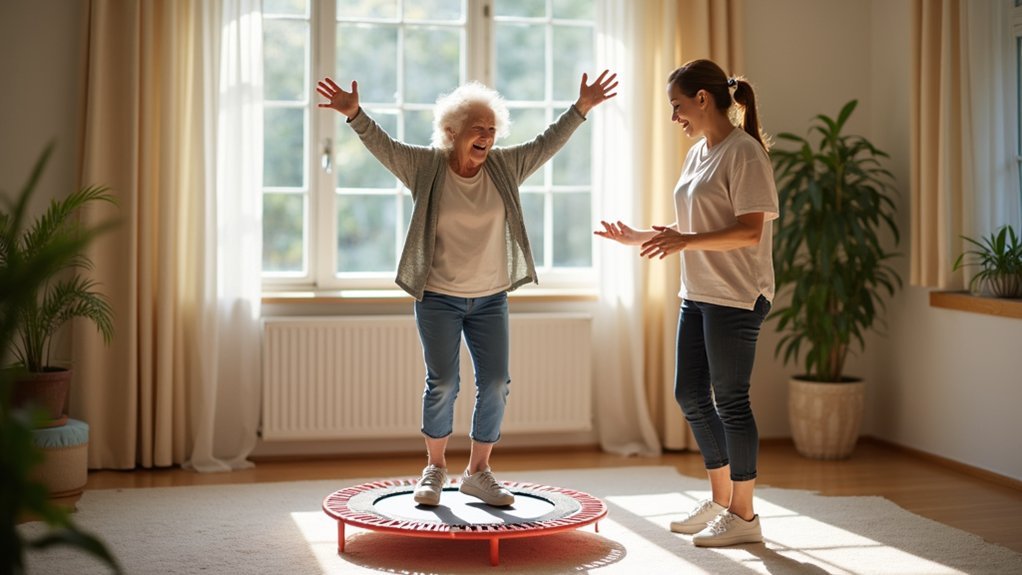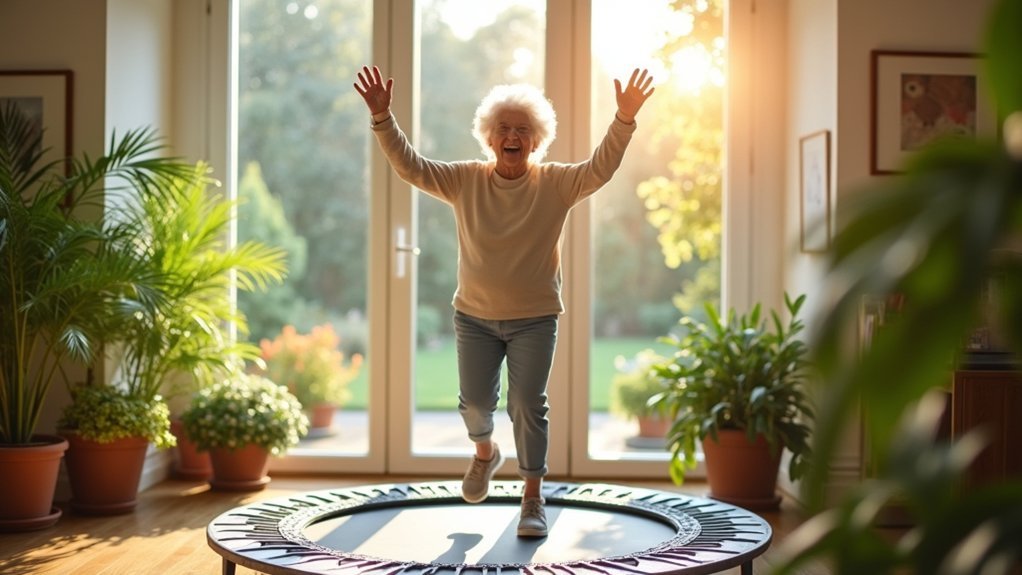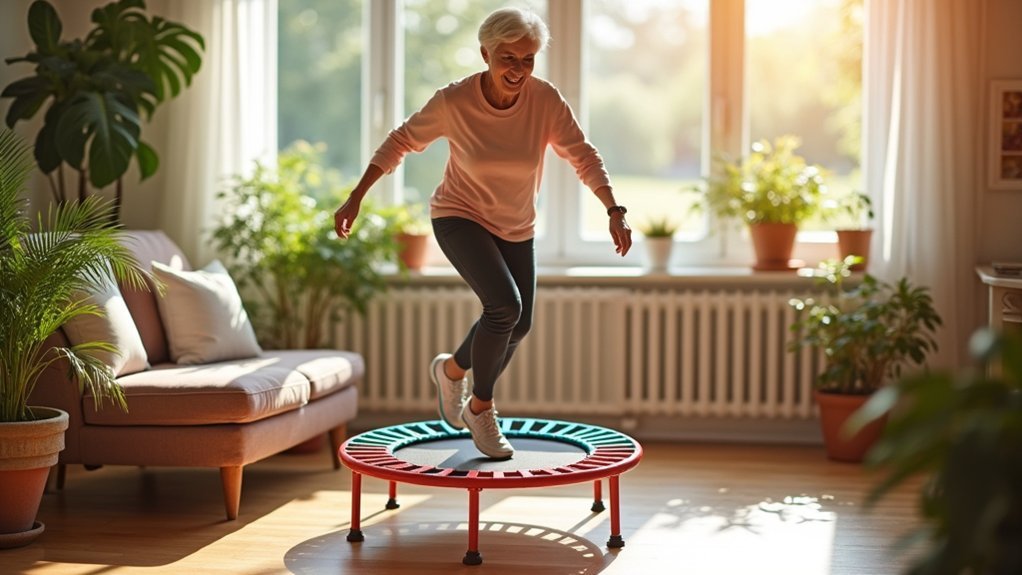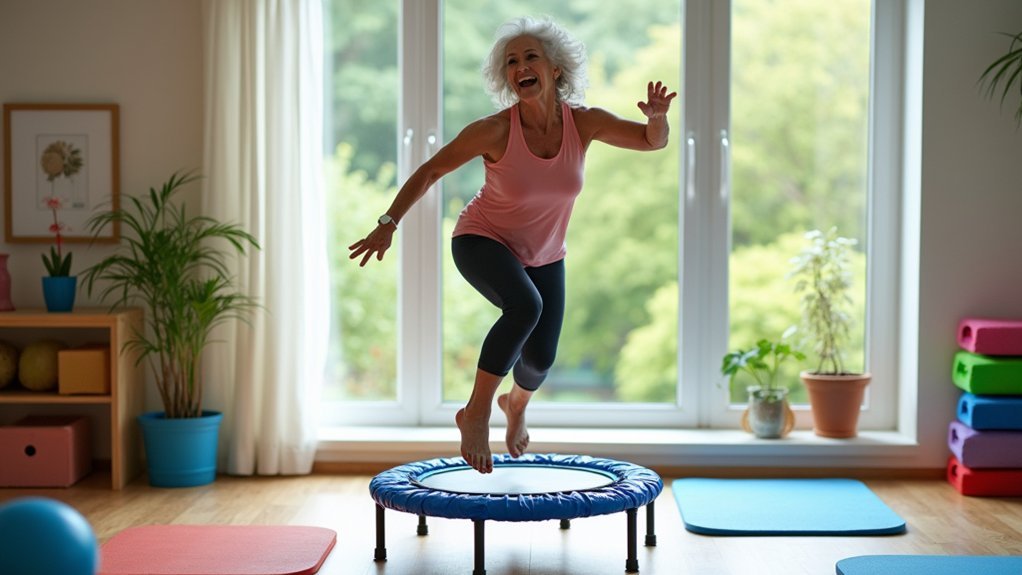Mini-trampolines offer seniors a gentle yet effective way to improve mobility with minimal joint stress. You’ll strengthen muscles, enhance balance, and boost cardiovascular health through low-impact bouncing exercises. Regular sessions can reduce fall risk by up to 35% after just 14 weeks by improving proprioception and dynamic stability. Start with just 5 minutes daily, using a trampoline with safety bars if needed. The surprising benefits of this enjoyable exercise extend far beyond what most seniors imagine.
Mini-Trampolines: A Safe Alternative for Aging Joints

While many seniors avoid exercise due to joint pain concerns, mini-trampolines offer a rejuvenating solution for those seeking to stay active.
Unlike running or traditional aerobics, these compact rebounders provide cardiovascular benefits without the harsh impact on your knees, hips, and ankles.
You’ll experience a cushioned bounce that greatly reduces injury risk, making it ideal if you have arthritis or other joint conditions.
The gentle bouncing motion delivers effective low-impact aerobic exercise that strengthens your heart while being kind to your body.
What makes mini-trampolines particularly suitable for seniors is their adaptability to different fitness levels. The repetitive bouncing helps enhance balance and coordination, which becomes increasingly important as we age.
You can adjust the intensity of your workout based on your abilities, ensuring you’ll get an effective exercise experience regardless of your current physical condition.
Balance and Fall Prevention Through Rebounding
Mini-trampolines offer you exceptional dynamic stability training that strengthens core muscles vital for preventing dangerous falls.
Regular rebounding exercises enhance your proprioceptive system, improving your body’s awareness of position and movement in space.
Clinical studies show that 14 weeks of consistent mini-trampoline workouts can improve your balance by 35 percent, significantly reducing fall risk.
You’ll build confidence through progressively challenging balance exercises, making everyday movements safer and reducing fear of falling that often limits senior activity.
Dynamic Stability Training
Because dynamic stability diminishes with age, seniors face increasing risks of falls and injuries that can dramatically impact their quality of life. Mini-trampolines address this by creating an environment where you’re constantly adapting to a moving surface. The actively aging population can particularly benefit from these exercises to maintain independence and mobility.
| Dynamic Stability Mechanism | How It Works | Benefit |
|---|---|---|
| Hip Moment Generation | Improves hip muscle response | Better recovery during imbalance |
| Plantarflexor Strength | Strengthens ankle muscles | Provides stable foundation |
| Real-time Adaptation | Forces quick adjustments | Enhances reflexive stability |
| Challenging Environment | Simulates unstable surfaces | Prepares for real-world scenarios |
| Neuromuscular Coordination | Improves brain-muscle communication | Faster response to instability |
These mechanisms work together to enhance your ability to recover from potential falls. The trampoline’s unstable surface trains your body to adapt quickly, improving your dynamic stability by up to 35% after consistent training.
Proprioceptive System Enhancement
As your body ages, the proprioceptive system—your internal sense of body position and movement—gradually becomes less reliable, directly impacting your balance and increasing fall risk.
Mini-trampolines offer an effective countermeasure, enhancing proprioception through specialized training.
Research shows twice-weekly sessions over 3-16 weeks notably improve balance metrics like the Time Up and Go test. You’ll benefit most in small groups of 5-8 participants, with sessions typically lasting 45-60 minutes.
The unstable surface of mini-trampolines challenges your sensory systems, forcing adaptation and improvement. Though a recent study at Pacific Lutheran University showed no significant differences in static balance after 16 weeks of training, researchers observed potential increases that warrant further investigation.
For safety, trampolines are equipped with supporting bars. When combined with complementary tools like therabands and balloons, the exercises become progressively challenging.
This thorough approach doesn’t just reduce fall risk—it also diminishes the fear of falling, enhancing your overall mobility and independence.
Confidence Building Exercise
Rebuilding your confidence after a fall or during mobility decline requires both physical and psychological interventions—mini-trampolines address both needs simultaneously.
Research shows these devices can reduce fall risk by improving your dynamic stability and balance recovery capabilities.
When you rebound regularly, you’ll experience up to 35% improvement in balance ability while strengthening essential muscles in a joint-friendly way. The gentle bouncing motion enhances your ability to recover quickly from unexpected stumbles without the harsh impact of traditional exercises.
As you gain physical competence through consistent mini-trampoline workouts, you’ll notice increased confidence in your daily movements. This positive cycle reduces fear of falling and encourages more physical activity, creating a sustainable approach to maintaining independence and mobility as you age. Adding supportive safety bars during mini-trampoline exercises can prevent falls and further boost confidence, especially for beginners.
Building Strength While Protecting Mobility
Mini-trampolines offer you a unique way to build muscle strength without the harsh impact that traditional strength training can inflict on aging joints.
Your body naturally engages multiple muscle groups with each bounce, developing functional power that translates directly to everyday movements like standing from a chair or climbing stairs. The micro bend in knees technique used in health bounces helps protect joints while still providing effective muscle engagement.
You’ll notice improved stability and mobility as your muscles strengthen through gentle resistance that protects rather than strains your joints.
Low-Impact Muscle Building
For many seniors seeking to build strength without risking injury, low-impact exercises represent the perfect solution. Mini-trampolines offer remarkable muscle-building benefits while minimizing joint stress.
When you rebound, you’ll strengthen multiple muscle groups simultaneously. Studies show a 10% increase in plantarflexors muscle strength and 35% improvement in balance recovery with regular trampoline use. You’re engaging your core, legs, and back with each bounce, enhancing your proprioception and dynamic stability.
Unlike traditional exercises, rebounding reduces injury risk while remaining accessible for those with arthritis or joint issues. You’ll likely stick with this exercise routine because it’s gentler on your body yet highly effective. NASA research demonstrated rebounding helps remineralize bones in situations where bone density loss occurs.
Short, regular sessions can considerably improve your functional mobility, muscle strength, and reduce your fear of falling—all essential factors in maintaining your independence.
Joint-Friendly Strength Training
While traditional strength training can strain aging joints, mini-trampolines offer a revolutionary approach to building muscle without the associated risks. The trampoline’s elastic surface provides progressive overload with considerably reduced impact compared to floor exercises.
You’ll benefit from compound movements that engage multiple muscle groups simultaneously, mimicking real-world mobility patterns like rising from a chair. This multi-joint focus directly improves your daily activities while strengthening the lower body to prevent falls. Focusing on these compound exercises is essential for effective joint protection as they engage multiple joints and muscle groups simultaneously.
Regular mini-trampoline exercise delivers consistent pain reduction through improved muscle support around arthritic joints. The gentle bouncing motion enhances shock absorption and reduces inflammatory markers.
For ideal results, aim for 2-3 weekly sessions with 8-12 repetitions of each movement. Even if you have arthritis, you can safely build strength with chair-assisted variations and appropriate resistance levels.
Functional Power Development
Beyond building foundational strength, functional power represents the next evolution in senior fitness—the ability to generate force quickly when you need it most.
Mini-trampolines excel at developing this power by emphasizing velocity over heavy resistance, creating movements that directly transfer to daily activities.
Your body develops critical power adaptations through rebounding:
- Faster force production – Improves your ability to catch yourself during balance disruptions
- Enhanced muscle coordination – Strengthens the synchronized muscle patterns needed for sit-to-stand movements
- Higher-threshold motor unit recruitment – Activates fast-twitch fibers that traditional exercises often miss
- Better reactive stepping – Trains your feet to respond quickly when maneuvering uneven surfaces
This power training requires 40-60% less resistance than traditional strength work while delivering superior functional results. Research supports that low intensity power training at just 20% of maximal strength can yield significant balance improvements in older adults.
The Science Behind Rebounding’s Impact on Bone Health
Research into mini-trampoline rebounding has revealed promising effects on bone health for seniors, though results vary across different skeletal regions.
Studies show older women with osteopenia experienced a significant 2% increase in femoral neck bone density after 12 weeks of rebounding, while their peers in control groups saw a 2% decrease in the same area.
The mechanism involves weight-bearing and repetitive loading, which stimulates osteoblasts and potentially increases bone formation. When you rebound, you’re creating impact forces that mimic the strain patterns found in younger individuals, potentially reducing osteoporosis risk.
While rebounding’s effects on lumbar spine density weren’t significant in studies, the exercise still offers valuable benefits by engaging multiple muscles simultaneously and promoting overall musculoskeletal strength—critical factors in preventing falls and maintaining mobility. However, seniors should be cautious as improper technique during rebounding can lead to vertebral compression fractures in individuals with existing bone density issues.
Cardiovascular Benefits Without High-Impact Stress

You’ll find mini-trampolines offer your heart a full workout without jarring your joints, as the bounce surface absorbs up to 87% of impact force compared to floor exercises.
Your cardiovascular system responds with improved circulation and increased oxygen utilization during each rebounding session, helping meet recommended heart rate targets for seniors.
The rhythmic bouncing motion strengthens your breathing capacity by engaging respiratory muscles while simultaneously boosting blood flow throughout your body. This gentle exercise can significantly increase heart rate without putting excessive strain on the cardiovascular system.
Heart-Smart Gentle Exercise
While traditional exercises can strain aging joints, mini-trampolines offer seniors a heart-healthy alternative that delivers impressive cardiovascular benefits without the punishing impact.
These rebounders absorb up to 80% of shock, making them ideal for those with orthopedic concerns.
You’ll find mini-trampolines provide an adjustable workout that’s both effective and enjoyable:
- Low-Impact Endurance Building – Strengthen your heart while protecting your joints through gentle bouncing sessions
- Metabolic Booster – Raise your metabolic rate to support weight management without high-intensity strain
- Interval Training Option – Use intermittent jumping patterns to improve heart health at your own pace
- Progressive Intensity – Start with short sessions and gradually increase duration as your fitness improves
Research has shown that rebounding exercises are often perceived as easier than running while still providing moderate-to-intense cardiovascular benefits.
Breathing Capacity Improvements
Breathing deeply becomes more challenging as we age, yet mini-trampolines offer seniors a remarkable way to expand lung capacity without taxing aging joints. The gentle bouncing motion naturally encourages deeper breathing patterns, increasing oxygen intake throughout your body.
As you rebound, your cardiovascular system engages efficiently, improving circulation and delivering oxygen-rich blood to your muscles and organs. This enhanced circulation helps strengthen your respiratory muscles, making each breath more effective. You’ll likely notice you can sustain activity longer without feeling winded.
Unlike high-impact exercises that might leave you gasping for air, mini-trampolines provide cardiovascular benefits at a comfortable pace. The rhythmic bouncing creates a natural breathing cadence that you can maintain while gradually building endurance—all while protecting your joints from stress that often accompanies traditional cardio workouts. Regular trampolining releases natural painkillers that further support respiratory comfort while exercising.
Improving Coordination and Brain Function With Bounce
How exactly does bouncing on a mini-trampoline benefit aging brains and bodies? When you bounce, you’re simultaneously training your balance, strength, and cognitive function.
Research shows that mini-trampoline programs enhance functional mobility and considerably improve your ability to regain balance before falling.
Your brain benefits from increased blood flow during rebounding exercises, which enhances:
Rebounding floods your brain with oxygen-rich blood, boosting cognitive function and mental clarity while you bounce.
- Memory and concentration abilities
- Executive functions and attention span
- Overall cognitive performance
- Mental health and wellbeing
The unstable surface of a mini-trampoline challenges your coordination systems in ways that standard exercises can’t match.
This unique stimulation helps your brain create new neural pathways while strengthening your muscles in a low-impact environment—making it an ideal exercise option when you’re concerned about joint health. Regular rebounding sessions can also help release mood-elevating endorphins that contribute to stress reduction and improved emotional wellbeing.
Getting Started: Choosing the Right Mini-Trampoline

Selecting the right mini-trampoline is vital for your safety and exercise success. Look for models with padded metal springs or bungee cords to reduce joint impact, with capacity for at least 150kg.
Choose a diameter between 38-55 inches for stability while maintaining portability. Non-slip feet are important, especially on hardwood floors. For durability, select steel frames with powder coating and 30-36 springs.
If space is limited, opt for foldable models like the Cardio Fitness Trampoline. Make certain you have 8-10 feet of ceiling clearance for unrestricted movement. Some rebounders come with safety handlebars for added stability while exercising, which is particularly beneficial for seniors.
Your budget will determine options: Costway (£45) for entry-level, Boogie Bounce Elite for mid-range quiet performance, or premium JumpSport 350 for advanced suspension.
Always verify handle availability, as some models require separate purchases.
Effective Beginner Rebounding Routines for Seniors
When beginning a mini-trampoline routine, seniors should start with gentle, accessible exercises that build confidence while delivering health benefits.
The low-impact nature of rebounding makes it ideal for maintaining joint health while improving cardiovascular fitness. Starting with 5 minutes daily and gradually increasing your session length by one minute each week will help build endurance safely.
Try these beginner-friendly exercises:
- Warm-up Bounce – Start with gentle bounces where your feet barely leave the surface to warm up muscles and improve circulation.
- Health Bounce – Alternate lifting each knee slightly while maintaining a gentle bounce to engage your core.
- Arm Raises – Add simple arm movements (forward, sideways, upward) while bouncing to enhance coordination.
- Step-Touch – Practice stepping on and off the trampoline carefully to improve balance shifts.
Remember to incorporate short water breaks and progress gradually as your confidence builds.
Tracking Your Progress: Mobility Milestones
Tracking your progress while using a mini-trampoline provides valuable insights into your mobility improvements and helps maintain motivation on your fitness journey.
Consider using the Elderly Mobility Scale (EMS), a standardized 20-point assessment tool that measures abilities in sitting, standing, and walking.
Set specific mobility goals and conduct evaluations every 4-6 weeks to identify significant milestones. These regular assessments help healthcare providers adjust your exercise regimen as needed.
Regular mobility evaluations every 4-6 weeks reveal your progress and allow for timely adjustments to your exercise program.
Remember that higher EMS scores indicate better mobility and can predict your independence level and fall risk. Scores under 13 suggest mobility concerns that may require further attention and support services.
The positive feedback from seeing your improvement creates a reinforcing cycle of engagement.
Your mini-trampoline routine isn’t just fun—it’s a measurable path to enhanced balance, strength, and overall mobility that you can track with confidence.
Combining Rebounding With Other Senior Fitness Approaches
To maximize the benefits of mini-trampoline workouts, integrating rebounding with complementary fitness approaches creates an all-encompassing mobility program for seniors. When combined thoughtfully, these exercises enhance overall health while maintaining joint protection.
- Balance + Rebounding – Pairing mini-trampoline exercises with specialized balance training can improve stability by up to 35%, reducing fall risk while enhancing proprioception.
- Strength Training Integration – Adding resistance exercises strengthens core, leg, and back muscles, complementing the cardiovascular benefits of rebounding. Sessions alternating between rebounding and strength work improve cardiovascular fitness and decrease heart disease risk in older adults.
- Bone-Building Combination – Regular rebounding with weight-bearing exercises increases bone density, essential for preventing osteoporosis.
- Social Fitness Options – Group rebounding classes provide both physical benefits and valuable social interaction, addressing holistic wellness needs.
Success Stories: Seniors Who Regained Mobility Through Rebounding
Individual success stories from seniors who’ve embraced mini-trampoline exercise reveal compelling evidence of rebounding’s transformative effects on mobility.
Consider the 40 women with osteopenia who not only maintained lumbar spine BMD while non-exercising peers lost 6%, but also increased femoral neck BMD by 2% after a 12-week program.
Research shows women with osteopenia maintained spine BMD and gained 2% femoral neck BMD while non-exercisers declined.
Most participants achieved these results with just two 45-60 minute sessions weekly. The transformative impact extends beyond bone health—35% balance improvements were documented after 14 weeks, alongside significant reductions in fear of falling.
Previously sedentary individuals in their mid-60s progressed from seated bounces to full-height jumps using adaptive handrails. Many participants found that using rebounders with bungee cords provided a smoother and safer experience during their rehabilitation journey. The results span demographic groups, including those with arthritis and neurological disorders, confirming rebounding’s effectiveness for seniors seeking mobility improvements.
Addressing Common Concerns About Trampoline Exercise for Older Adults
While these success stories showcase rebounding’s potential benefits, many seniors still harbor legitimate concerns about mini-trampoline exercise. Understanding these worries is the first step toward safely incorporating rebounding into your fitness routine.
Most common concerns include:
- Balance and fall risks – Seniors with impaired balance face higher risks, but handlebar-equipped trampolines can provide essential stability.
- Joint health considerations – Though rebounding is low-impact, those with arthritis should start gradually and monitor discomfort. The vertical motion of rebounding helps strengthen bones and can be beneficial for preventing osteoporosis when done safely.
- Mobility challenges – Getting on and off the trampoline can be difficult, so proper placement against a wall offers additional support.
- Underlying health conditions – Osteoporosis, heart disease, and hypertension require special precautions and medical clearance before beginning.
Always consult your doctor before starting any trampoline exercise program.
Frequently Asked Questions
How Long Should Seniors Rest Between Mini-Trampoline Workout Sessions?
You should rest one to two days between mini-trampoline workouts. Listen to your body and adjust based on your age, fitness level, and health conditions. Consult your healthcare provider for personalized advice.
Can Rebounding Exercises Help Manage Diabetes in Seniors?
Yes, you’ll find rebounding helps manage diabetes by reducing insulin resistance, improving lipid profiles, and lowering central obesity. It’s also effective for glycemic control and enhances your overall quality of life as a senior.
Are Mini-Trampolines Covered by Medicare or Insurance Plans?
Medicare typically doesn’t cover mini-trampolines directly. However, you might access rebounding exercises through Medicare Advantage Plans with SilverSneakers benefits. Check your specific plan for fitness program coverage that includes these activities.
What Clothing and Footwear Are Best for Senior Rebounding?
Wear comfortable, fitted clothing like compression leggings and moisture-wicking tops. Choose minimalist shoes or grip socks for stability. Avoid loose garments that could snag and opt for high-waisted designs that provide abdominal support.
Can Mini-Trampoline Workouts Help Improve Sleep Quality for Seniors?
Yes, you’ll sleep better with mini-trampoline workouts. They release endorphins, raise and then cool body temperature, reduce stress hormones, and create physical fatigue—all helping you fall asleep faster and stay asleep longer.
In Summary
You’ve learned how mini-trampolines offer a gentle yet effective exercise option for your aging body. By incorporating regular rebounding sessions, you’ll improve balance, strengthen bones, and boost cardiovascular health without stressing your joints. Don’t let age limit your mobility—start with just minutes a day and you’ll likely notice improved stability and energy. Remember, it’s never too late to bounce back into an active lifestyle.





Leave a Reply